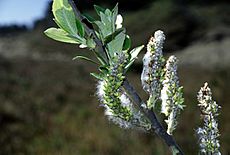Dune willow facts for kids
Quick facts for kids Dune willow |
|
|---|---|
 |
|
| Scientific classification | |
| Genus: |
Salix
|
| Species: |
hookeriana
|
 |
|
| Natural range of Salix hookeriana | |
 |
|
| Close-up of natural range of Salix hookeriana | |
| Synonyms | |
|
|
Salix hookeriana is a type of willow plant. It is commonly known as the dune willow, coastal willow, or Hooker's willow. You can find it growing along the coast in North America.
What it Looks Like
The Salix hookeriana can be a shrub (a bushy plant) or a small tree. It can grow up to about 8 meters (26 feet) tall. Sometimes, it forms thick groups of plants that spread out. Its leaves are usually oval-shaped and can be up to 11 centimeters (4.3 inches) long. They have wavy edges and feel hairy or woolly. The top side of the leaves is often shiny.
The plant's flowers grow in a special cluster called a catkin. These catkins can be up to 9 centimeters (3.5 inches) long. The female catkins get even longer as the plant's fruits start to grow. This willow can sometimes mix with other similar willow types, creating hybrid plants.
Its Name and History
The second part of the plant's scientific name, hookeriana, honors a person. It is named after William Jackson Hooker. He was a famous writer who first described this plant in his book, "Flora Boreali-Americana."
Where it Grows
The dune willow naturally grows along the west coast of North America. Its range stretches from Alaska all the way down to northern California. It likes to grow in coastal areas. This includes beaches, marshes (wetlands), floodplains (flat land near rivers), and canyons.
-
At the Humboldt Bay National Wildlife Refuge, California
See Also
 In Spanish: Salix hookeriana para niños
In Spanish: Salix hookeriana para niños


